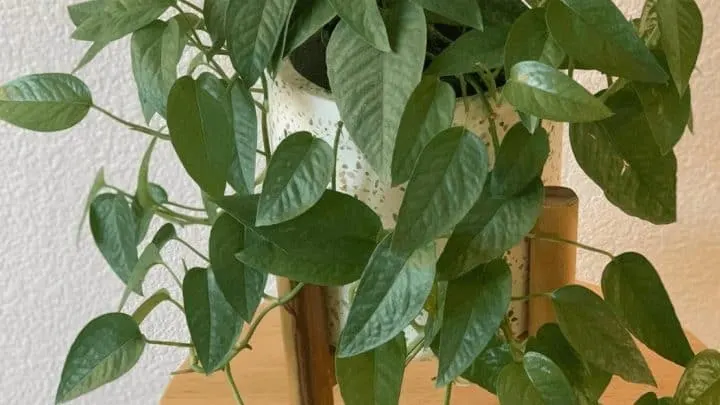(image credit, IG: pretty_little_planty)
For those plant lovers looking for a pothos variety with a twist, the Cebu Blue pothos or Epipremnum pinnatum ‘Cebu Blue’ is the sparkling gem for you. It also purifies the air!
A part of the Araceae family, you may also hear this pothos type referred to as Blue pothos, Devil’s Ivy, Dragon-tail, Blue philodendron, and even Centipede Tongavine!
Table of Contents
Cebu Blue pothos Takeaways
| Species | Epipremnum aureum 'Cebu Blue' |
| Synonyms | Cebu Blue Pothos, Blue Poths |
| Family | Araceae |
| Genus | Epipremnum |
| Growth | Climber |
| Height | 40 feet |
| Width | 6 feet |
| Soil | Potting mix or peat moss with added perlite or pumice |
| Watering | Water every 7 to 14 days |
| Light | Bright indirect |
| Temperature | 60 to 90°F |
| Humidity | 40-80% |
| Fertilizer | Fertilize monthly |
| Propagation | Stem cuttings |
| Toxicity | Toxic to humans, cats, and dogs. Contains calcium oxalate crystals. |
Cebu Blue pothos Care
To care for a Cebu Blue pothos use well-draining soil by adding perlite, vermiculite, and sand. Make sure your pothos gets medium light and water when the soil is dried out by giving it a good soak until the water comes out of the pot’s drainage holes. Keep temperatures between 60 °F to 90 °F (16-32 °C). Optimal humidity levels for this plant are around 70%. Fertilize once a month in spring and summer when you see the growth of your pothos slow down.
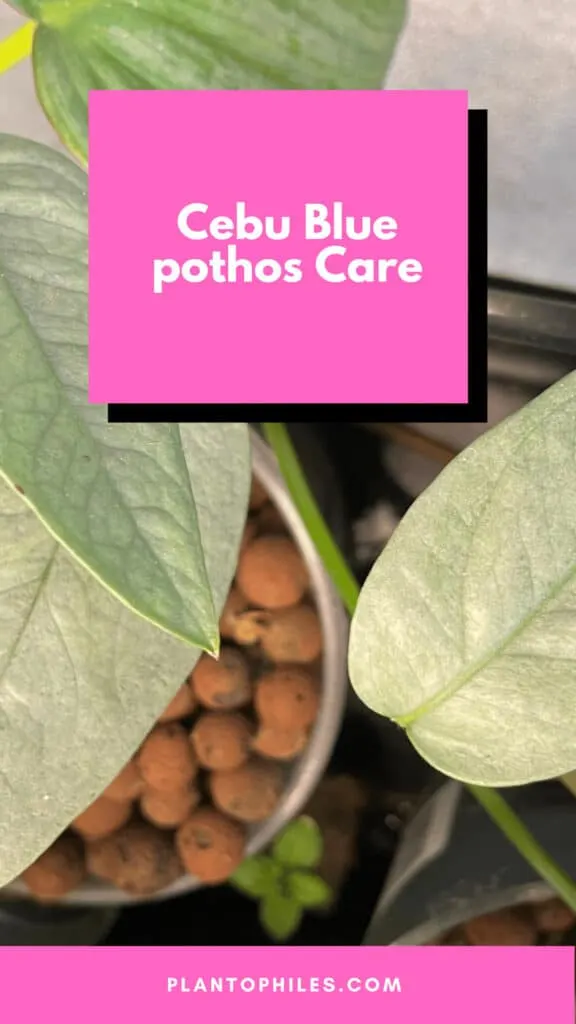
What is a Cebu Blue pothos?
The scientific name for Cebu Blue pothos is Epipremnum Pinnatum. It is an epiphyte growing on other plants and objects. Most plants from the Aroid family (Araceae) are epiphytes.
Commonly displaying a silvery sparkling pattern, a Blue pothos boasts the most spectacular foliage. This can mean variations from luscious dark green leaves to blue-silvery long leaves.
Native to the Philippines, this plant is also widely found in tropical places, such as Asia, Taiwan, and Japan. Reports even record it in abundance in Northern Austria, South, Central America, and even the West Indies.
One of the many common mistakes newbie plant owners make with a Cebu Blue pothos is mistaking it for a Monstera!
Though this pothos type does, at first glance, resemble a Monstera, they are two different species. If you look closely at each stem, a Cebu Blue pothos has a hard rough stem, while the Monstera has a smooth stem.
Here I share my advice on encouraging the best Cebu Blue pothos care. So, you can enjoy this easy-care plant for many years to come.
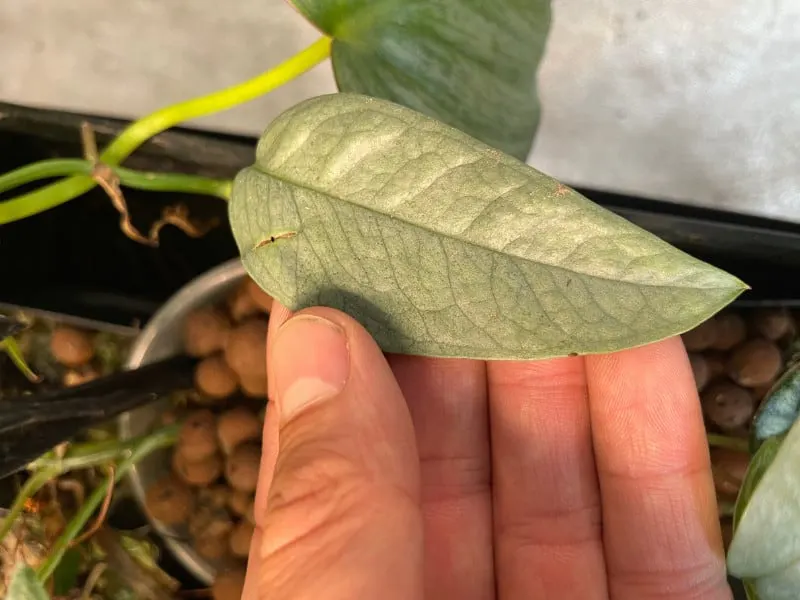
Cebu Blue pothos soil
Like all pothos plants, the Cebu Blue pothos needs a well-draining soil mix.
However, this soil mix must also provide a balanced PH mix to encourage Cebu Blue to grow and thrive.
I recommend monitoring the soil level here and aiming for a 6.1 to 7.8 pH balance.
Perlite is another element I like to add to my Cebu Blue pothos soil mix. It adds aeration.
You can also look for other ingredients here in your soil mix. This can include perlite, vermiculite, or even sand and orchid bark.
An alternative way is using 100% sphagnum moss.
In fact, the chunkier your soil mix, the better for your ongoing Cebu Blue pothos care.
Cebu Blue pothos Light Requirements
The Cebu Blue pothos prefers medium light or bright indirect light.
Through many, a Tibitib plant (just yet another name for this plant) will grow in low light. For better growth, opt for bright light.
This means never allowing it to sit within the glare of bright direct sunlight. This is a surefire way to encourage scorched leaves.
As this pothos species is a woodland plant, it’s worth considering how it would perform well in its natural habitat. So, aim for a good day’s light before encouraging a respite overnight.
You can use a grow light for Cebu Blue pothos. Ensure to turn it off overnight. Use it for 10-12 hours max. a day.
Watering
Only watering your Cebu Blue pothos when the soil is almost dried out. Then when you do water, give it a thoroughly good soak about once every 7-14 days.
It is called the soak-and-dry method.
A finger placed into the soil is always the best way to test the texture of your plant soil. If the potting mix is wet and soggy, hold off watering. Slightly moist soil is fine.
If you’re unsure when the best time to water is, look at the plant.
A Cebu Blue pothos that needs a drink will look like it’s beginning to wither and will even begin to put out curled leaves.
Once you get the action of watering just right, you’ll see a remarkable difference in your Cebu Blue pothos care.
The Ideal Temperature for this Pothos
The ideal temperature is 60 °F to 90 °F (16-32 °C) for Cebu Blue pothos. General household temperatures are sufficient. Ensure that the temperature is consistent and avoid fluctuations.
Keep this plant away from air-conditioners, fans, and heating units.
What Humidity is Best?
A humidity level of 70% is optimal for Cebu Blue Pothos.
This pothos variety copes fine with the general household humidity. But it will thrive more in high humidity.
A Cebu Blue pothos can also be misted to increase its humidity levels. When misting, ensure the leaves do not stay wet for more than 30 minutes. Allow for sufficient airflow. It can also be placed on a pebble tray.
I know many plant experts that put Cebu Blue pothos close to other plants to increase the humidity.
You can also use a humidifier to increase the humidity.
Use Fertilizer to Get Faster Growth
To increase your overall Cebu Blue pothos care, a balanced liquid plant fertilizer once a month in Spring and Summer will help your plant on its way during the growing season.
Yet, some people find that this task doesn’t need to be performed so often with this species. This is because they usually tend to be such good growers whether you fertilizer them – or not!
For this reason alone, I work because if my Cebu Blue pothos needs good feed in spring and summer, I offer it a well-balanced fertilizer.
But, if my pothos is having a burst of growth on its own, I let it do its thing naturally.
Cebu Blue pothos Propagation
Cebu Blue pothos propagation is easy. Pothos are known for being the easiest plants to propagate. The best way is using stem cuttings and rooting them in water. After 2-3 weeks, you can transfer the cuttings to soil mix. The roots should be 2-3 inches long (5.0-7.5cm).
The Cebu Blue pothos must be the easiest plant I’ve ever propagated! This perhaps accounts for why I have so many plants potted up from the mother Cebu Blue around my home!
All you need to propagate this plant is a few cuttings, and a fresh pot of soil mix you already use for your newly established Cebu Blue pothos plant.
Cut under a node. This is where you’ll see new growth when propagating this plant.
Use a healthy stem section when cutting the plant with scissors or pruning shear. Older sections that are already woody are harder to propagate.
Growth Rate
Cebu Blue pothos is a fast grower. It can grow up to 4 feet per year (1.2 meters).
Prune regularly so the plant does not get out of hand.
A Cebu Blue pothos can look straggly, leggy, and gangly if unchecked. For this reason, I like to prune and train the plant to go in specific directions.
You can keep these pothos in a hanging basket and let them trail. Alternatively, use a moss pole to let them climb.
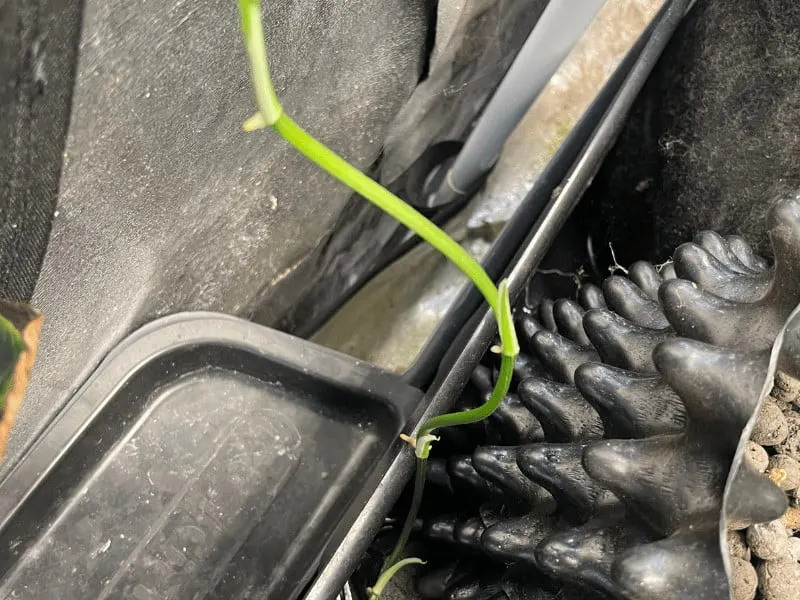
During winter, this pothos often goes into dormancy. So, don’t panic if your plant slows down or stops growing during this short period.
Potting
The ideal time to repot this pothos plant is when you see its leaves splitting and maturing. By actively moving up pot sizes when required, a Cebu Blue pothos can thrive. Repot every 1-2 years.
Another aspect of providing good Cebu Blue pothos care means you can play around with a varied selection of pots to display your plant.
This is more of a possibility if you have a good fast grower on your hands and/or you regularly propagate it.
One thing I will also say from personal experience is that you need to plan your pot type carefully beforehand.
This means if you aren’t looking for your Cebu Blue pothos to mature quickly, a hanging basket will keep them in the juvenile phase for longer.
Gardeners’ World rates the pothos species as one of the best trailing house plant display choices.
How To Propagate Cebu Blue Pothos – Step-By-Step
Propagating Cebu Blue Pothos in Soil
- Try to perform this job around springtime or at least when the weather starts to warm up. Also, never attempt to propagate when your Cebu Blue pothos is dormant.
- Look for the best stems of your plant and choose a few for the best results.
- Make a small sharp, precision cut towards the base of the stem and underneath a node.
- Remove some leaves at the base of these cuttings to ensure no leaves will be immersed in soil.
- Make up a small pot of fresh soil using the same ingredients that your mother plant grows in.
- Make a swell in the soil with your finger and carefully place the stems.
- Pat the soil down around the stems gently to hold them in place.
- Water your cuttings gently and leave them to stand.
- Move the pot to a well-lit home area, preferably with natural light. For increased heat, you can also place a clear plastic bag over them during this period.
- Keep a regular check on your cuttings and water when necessary.
Cebu Blue pothos Water Propagation
Pothos can easily be propagated in water. Instead of placing cuttings in soil, place them into a glass or jar of tepid water.
Move this jar/pot to a well-lit area and watch the cuttings grow roots.
Change the water every 5-7 days.
Repot to potting soil once the roots are 2-3 inches long (5.0-7.5 cm).
You can also grow Cebu Blue pothos in water indefinitely. Add liquid fertilizer every 2-4 weeks. Exchange the water frequently.
Does a Cebu Blue pothos fenestrate?
Cebu Blue pothos starts to fenestrate once it matures. The juvenile plant looks very different from a mature specimen.
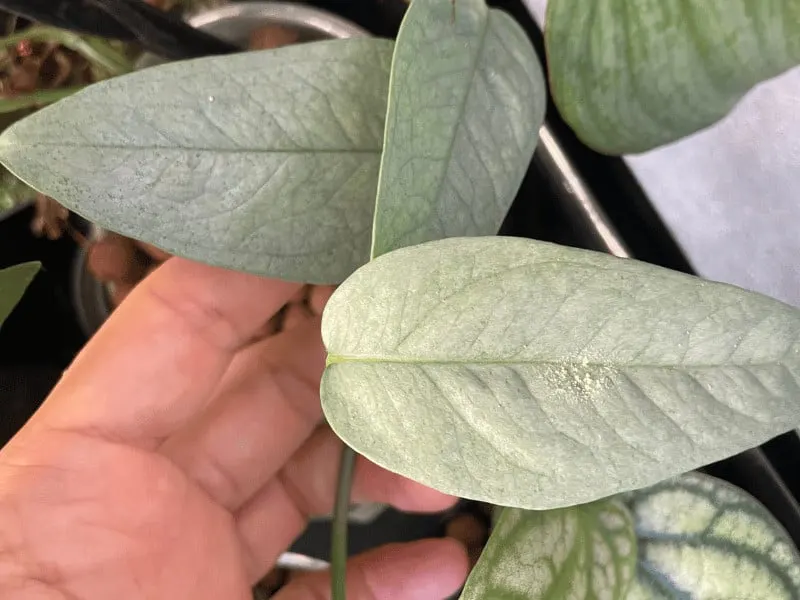
The large the leaves get, the more the plant matures. Adult leaves have perforations and holes. The slits get more the larger the leaves get.
Climbing and clinging to objects helps a Pothos to grow bigger leaves.
How Does a Cebu Blue Pothos Mother Plant Look Like?
A Cebu Blue pothos mother plant has multiple slits and elongated leaves. The leaves lose their shine and silvery texture and are almost completely green.
Cebu Blue Pothos Problems
Though Cebu Blue pothos care is relatively straightforward, several issues may crop up from time to time.
A Cebu Blue pothos is relatively disease-resistant if you’re observant and keep on top of your plant.
However, I’ve personally experienced mealybugs on odd occasions. Likewise, I know of others that have battled scale with his one.
Apart from that, the obvious common problem I envisage some people encountering with this plant is overwatering. This results in visual issues such as soggy leaves and possibly droopy-looking leaves.
Cebu Blue pothos Mealybugs Infestation
Mealybugs are every plant lover’s worst nightmare. The Cebu Blue pothos are no more susceptible to them than others, but once they get them, eliminating them can be a pain.
Though I’ve had two outbreaks of mealybugs with my pothos, the culprit has been other plants both times. This is also how mealybugs spread.
So, a word of warning – when you bring in a new plant to your home, isolate it for a week or two first. This means checking Cebu Blue pothos for pests and issues as soon as it enters your home.
Mealybugs and scale will not kill your plant – but if left unchecked, they will, over time, start to affect your plant’s health and, indeed, growth.
You can easily rid of infected areas by using a cotton bud with insecticidal soap and physically removing the culprits.
Water your plant with a gentle hose spray and quarantine it for a few days to check for potential re-offenders.
Other common bugs on a Cebu Blue pothos are thrips and spider mites.
How Do I Know My Cebu Blue Pothos is Overwatered?
A Cebu Blue pothos that is overwatered will get yellow leaves. Yellow leaves are a common sign in houseplants that something is not right.
Like most plants, a Cebu Blue pothos will not grow to its full potential if left to sit in soggy soil for a long period.
These plants like to dry out a little before demanding their next drink.
One surefire way that you’re overwatering, this pothos is if your soil mix stays soggy for several days. Droopy-looking leaves can be a sign of either underwatering or overwatering.
A healthy Cebu Blue pothos will face up towards the light source. But, if yours looks depressed with curling leaves and soggy leaves or stems, it could suffer from overwatering.
This issue, too can be so easily remedied by simply taking a few seconds to check the state of the soil.
Why does my Cebu Blue Plant Have Brown Leaves?
Brown leaves on a Cebu Blue plant are caused by underwatering, too much direct sunlight, fertilizer, or pests.
The most common reason if direct sunlight is not the culprit is underwatering. Therefore stick to a regular watering schedule.
Frequently Asked Questions
Is Cebu Blue pothos toxic to pets?
Cebu Blue pothos is toxic to pets such as cats, dogs, and humans. So, if you own this plant and have pets or children in your home, you’ll need to make arrangements to keep it out of their way.
If the leaves of Cebu Blue pothos are ingested, they can cause tongue and mouth swelling. The potential for swelling problems is also greater in more severe cases.
To err on the side of caution, aim to keep this plant off the floor or in an area whereby your pet could easily access it. This could mean rethinking where you hang your plant if it’s in a basket and heading toward the floor area.
I don’t have much time to devote to plant maintenance. But I still want a Cebu Blue Pothos. Is this the right choice for me?
As one of the lowest maintenance plants, like all pothos tend to be, I recommend the Cebu Blue pothos to all those who want a minimal demanding plant! Once you have its position and watering requirements right, a Cebu Blue pothos will happily sit and grow.
This makes it the ideal plant for those with little time or prior house plant experience.
What exactly happens when a Cebu Blue pothos goes into dormancy?
Dormancy for a Cebu Blue pothos means it’s taking its usual annual rest. Like we humans wind down in the winter, so too do many plants in this genus.
So, you’ll note it stops growing as much, possibly even stops growing altogether during this time.
All you need to do is allow it to rest, watering it only if it needs it here.
It will consume all the food and water in its soil during this time.
Then, when the spring months start to rear their head, so will your Cebu Blue pothos.
Conclusion
When you get your Cebu Blue pothos care just right, you, too, can look forward to a trailing plant with some of the most unique foliage.
This is a great plant for those who don’t care for anything fussy but still want to benefit from its fantastic display of blue-silvery colored leaves.
An undeniably good-looking pothos choice, if you can offer a Cebu Blue pothos a stable home environment, this plant will reward you with fantastic growth for many years.

Daniel has been a plant enthusiast for over 20 years. He owns hundreds of houseplants and prepares for the chili growing seasons yearly with great anticipation. His favorite plants are plant species in the Araceae family, such as Monstera, Philodendron, and Anthurium. He also loves gardening and is growing hot peppers, tomatoes, and many more vegetables.

